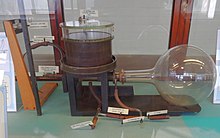 The original cloud chamber of C. T. R. Wilson at the Cavendish Lab, Cambridge, England. | |
| Uses | Visualizing ionizing radiation |
|---|---|
| Notable experiments | Discovery of the positron |
| Inventor | Charles T. R. Wilson |
| Related items | Bubble chamber Wire chamber |
| Antimatter |
|---|
 |
A cloud chamber, also known as a Wilson chamber, is a particle detector used for visualizing the passage of ionizing radiation.
A cloud chamber consists of a sealed environment containing a supersaturated vapor of water or alcohol. An energetic charged particle (for example, an alpha or beta particle) interacts with the gaseous mixture by knocking electrons off gas molecules via electrostatic forces during collisions, resulting in a trail of ionized gas particles. The resulting ions act as condensation centers around which a mist-like trail of small droplets form if the gas mixture is at the point of condensation. These droplets are visible as a "cloud" track that persists for several seconds while the droplets fall through the vapor. These tracks have characteristic shapes. For example, an alpha particle track is thick and straight, while a beta particle track is wispy and shows more evidence of deflections by collisions.
Cloud chambers were invented in the early 1900s by the Scottish physicist Charles Thomson Rees Wilson. They played a prominent role in experimental particle physics from the 1920s to the 1950s, until the advent of the bubble chamber. In particular, the discoveries of the positron in 1932 (see Fig. 1) and the muon in 1936, both by Carl Anderson (awarded a Nobel Prize in Physics in 1936), used cloud chambers. The Discovery of the kaon by George Rochester and Clifford Charles Butler in 1947 was made using a cloud chamber as the detector.[1] In each of these cases, cosmic rays were the source of ionizing radiation. Yet they were also used with artificial sources of particles, for example in radiography applications as part of the Manhattan Project.[2]
- ^ "The Nobel Prize in Physics 1936". The Nobel Prize. Retrieved 7 April 2015.
- ^ C.L. Morris; et al. (2011). "Flash radiography with 24 GeV/c protons". Journal of Applied Physics. 109 (10): 104905–104905–10. Bibcode:2011JAP...109j4905M. doi:10.1063/1.3580262.